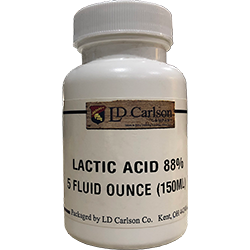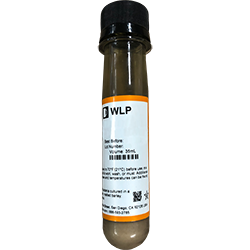Lactic Acid In Your Beer: Sometimes You Need a Little Sour to Appreciate the Sweetness
Posted by Matteo Lahm on 23rd Jun 2023
As a homebrew enthusiast, you're always looking for ways to enhance the complexity of your beers. Variety is the spice of life and one ingredient that can significantly impact your beer's taste is lactic acid. In this article, we'll discuss what lactic acid is, why it's used in beer making, how it changes the flavor of your beer, and also when it might not be the best choice. Additionally, we'll provide a guide on how to best use lactic acid in your brewing process.
What is Lactic Acid?
Lactic acid is a natural organic acid involved in various biochemical processes. It is produced by lactic acid bacteria (LAB) during fermentation and is responsible for the tangy, sour taste found in yogurt, sauerkraut, and certain beers. In brewing, lactic acid plays a significant role in balancing and enhancing these flavor characteristics in your beer.
Why Use Lactic Acid in Beer Making?
1. Lactic acid can introduce a refreshing tartness to your beer, making it more enjoyable and thirst-quenching.
2. If your beer is too sweet, lactic acid can help balance the flavor by adding a touch of sourness.
3. Lactic acid is essential for brewing sour beers like Berliner Weisse, Gose, or Lambic, as it provides their characteristic tangy flavor.
How Does Lactic Acid Change the Flavor of Your Beer?
The addition of lactic acid can transform a simple beer into a more complex and multi-layered beverage. The key is to use lactic acid judiciously – too little, and its effects will be barely noticeable; too much, and your beer might taste overly sour. There are several ways to introduce lactic acid into your beer.
1. When using liquid lactic acid, it's best to add it during the final stages of the brewing process, specifically at the end of fermentation or during the conditioning phase. This allows you to have better control over the final acidity and flavor profile of your beer. For a 5-gallon batch, it's recommended to start with a small incremental amount of liquid lactic acid, such as 1 ml or even less, depending on your desired level of tartness. After adding the initial amount, taste your beer and decide if you'd like to increase the acidity. If needed, continue adding lactic acid in increments of 0.5 to 1 ml, tasting the beer after each addition, until you achieve the desired flavor profile. Remember that it's easier to add more lactic acid than to remove it, so proceed with caution and make adjustments gradually.
2. A sour mash involves mashing your grains as usual, then cooling the mash to around 120°F (49°C) and adding a small amount of crushed malt or uncrushed grain. This encourages the growth of lactic acid bacteria, which will produce lactic acid during the mash. After 24-48 hours, you can continue with your regular brewing process.
3. Some yeast strains, such as Lactobacillus or Pediococcus, are known for producing lactic acid during fermentation. Commercial beer yeast strains containing Lactobacillus or Pediococcus can be used alone or in combination with other yeasts, depending on the desired outcome. When used alone, these strains will produce a more pronounced sourness and acidity in the beer, as they are the primary fermenting agents. This approach is suitable for styles like Berliner Weisse or Gose, where a distinct sourness is desired.
However, if you're looking for a more balanced flavor profile with a subtle tartness, you can combine Lactobacillus or Pediococcus strains with other yeast strains, such as Saccharomyces. This co-fermentation approach allows the primary yeast to contribute to the beer's overall flavor and fermentation, while the Lactobacillus or Pediococcus strains add a touch of acidity and sourness. The combination of yeasts can result in a more complex and nuanced flavor profile, suitable for a wider range of beer styles.
A beer maker might choose between Lactobacillus and Pediococcus based on the specific characteristics and fermentation properties of each strain, as well as the desired flavor profile and style of the beer being brewed.
Lactobacillus strains are generally faster-acting and produce a more pronounced sourness compared to Pediococcus. They are often used in kettle souring or quick souring methods, where the goal is to achieve a clean, tart flavor in a relatively short amount of time. Lactobacillus strains are commonly used in brewing styles like Berliner Weisse, Gose, and American sour ales, where a bright and refreshing acidity is desired.
Pediococcus strains, on the other hand, are slower-acting and produce a more subtle sourness. They are often used in traditional, long-term aging processes, such as those employed in the production of Lambics and Flanders Red Ales. Pediococcus strains can contribute to the development of complex flavors and aromas, including fruity, funky, and earthy notes, which are characteristic of these beer styles. However, Pediococcus can also produce diacetyl, a compound that imparts a buttery or slick mouthfeel, which may require additional aging or the use of a secondary yeast strain, like Brettanomyces, to clean up the diacetyl and further develop the beer's flavor profile.
Your choice between Lactobacillus and Pediococcus will depend on the desired sourness level, fermentation timeline, and the specific beer style being brewed.
When Shouldn't You Use Lactic Acid?
If you're aiming for a clean, crisp beer like a Pilsner or an American Pale Ale, do not use lactic acid. These styles rely on a straightforward flavor profile, and the addition of lactic acid could detract from their intended taste.
Conclusion:
Lactic acid is a valuable ingredient for homebrewers looking to create unique and complex flavors in their beer. By understanding its role in beer making and using it wisely, you can craft beers that will delight your taste buds and impress fellow beer enthusiasts. So, the next time you're brewing up a batch of beer, consider experimenting with lactic acid to unlock new flavor possibilities. Happy brewing!



